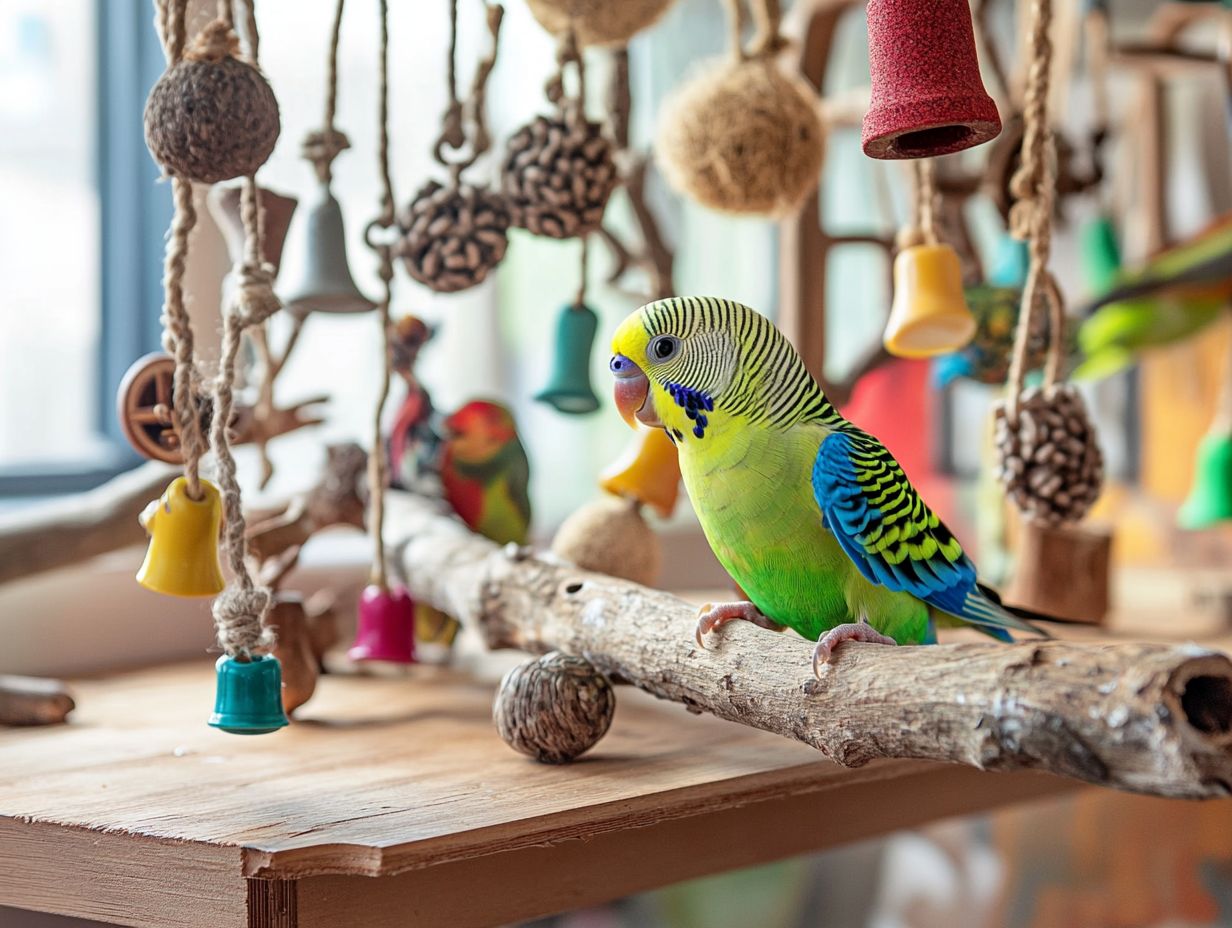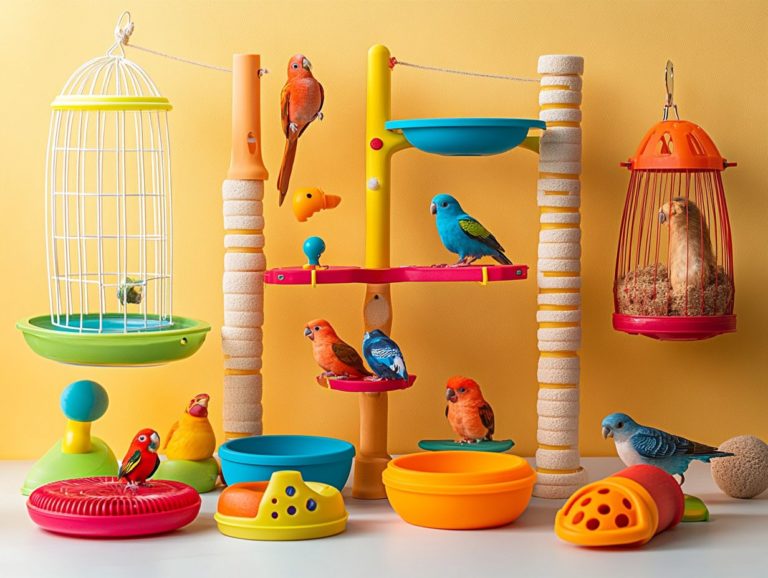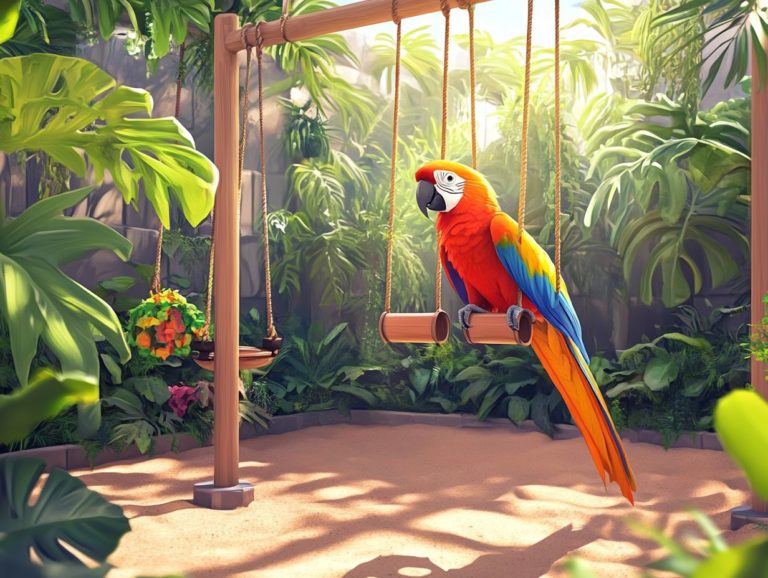How to Balance Fun and Safety in Bird Toys
When it comes to your feathered friends, playtime is essential for their physical and mental well-being, especially for pets like parrots and other birds.
Not all bird toys, such as DIY options, are created equal. Choosing safe and engaging toys is crucial for your bird’s health and happiness.
You ll also find valuable tips on monitoring and maintaining these toys to ensure a fun yet secure environment for your pet birds. Whether you’re a seasoned bird owner or just starting your avian journey, this guide will help you strike the perfect balance between enjoyment and safety.
Contents
- Key Takeaways:
- The Importance of Safe Bird Toys
- Factors to Consider When Choosing Bird Toys
- Types of Bird Toys
- DIY Bird Toys
- Tips for Monitoring and Maintaining Bird Toys
- Balancing Fun and Safety in Bird Toys
- Frequently Asked Questions
- How do I know if a bird toy is safe for my pet? Is it made from non-toxic materials that are sturdy?
- How can I make sure my bird has fun while playing with toys?
- What are some common hazards to look out for in bird toys?
- How can I encourage my bird to play with toys?
- What should I do if my bird seems afraid of a new toy?
- How often should I replace my bird’s toys?
Key Takeaways:

- Choosing safe toys helps prevent behavioral issues.
- Consider size, material, and durability when selecting toys.
- Engage your bird with interactive and safe DIY options.
The Importance of Safe Bird Toys
Safe bird toys are essential for the well-being of your feathered companions. They provide vital mental and physical stimulation, promoting a healthy lifestyle and preventing behavioral issues.
When choosing the right toys, prioritize materials that pose no risks, such as stainless steel and vegetable leather. Ensure they are free from harmful paints or glues. It s your duty to create an environment that emphasizes the health and safety of your birds.
By opting for high-quality products and engaging with a caring community of fellow bird enthusiasts, you can ensure that your birds not only survive but truly thrive!
Why Choosing Safe Toys is Critical for Your Bird’s Health
Choosing safe chew toys for your bird is vital for their overall health and well-being. Inappropriate toys can lead to injuries or behavioral issues that you definitely want to avoid.
Unsafe toys present several health risks, such as injuries from sharp edges that can cause cuts or wounds, or toxic materials that could lead to serious health complications if ingested. For example, wooden toys made from untreated wood may splinter, while colorful plastic toys might contain harmful chemicals.
On the flip side, opting for safe choices like natural sisal ropes and untreated wood blocks minimizes these risks and encourages healthy behaviors such as chewing and climbing. These types of toys stimulate your bird’s natural instincts, promoting both exercise and mental engagement, which are vital for their well-being!
Factors to Consider When Choosing Bird Toys
When selecting bird toys, consider several vital factors that significantly influence your pet’s happiness and well-being. You ll want to look at size, material, and durability, as these elements determine both the safety of the toy and its fit for your specific bird species.
It’s crucial to ensure the size is appropriate to prevent any choking hazards. Selecting non-toxic materials that can endure the enthusiastic chewing of active birds is equally important. Additionally, understanding the importance of variety in bird toys can enhance their play experience. You must also monitor the wear and tear of the toys to ensure they remain safe for ongoing enjoyment.
Size, Material, and Durability
The size, material, and durability of bird toys are essential for their effectiveness and safety, allowing both large and small birds to enjoy them without any risk. For more insights, check out this guide on how to create a toy rotation for your bird.
Keep in mind that different species have unique preferences and behavioral needs. For instance, larger birds like macaws thrive on sturdy stainless steel toys that can withstand their vigorous chewing and climbing. In contrast, smaller parakeets often gravitate toward lighter materials like cardboard, which they can easily manipulate, though it may not stand the test of time.
Wood brings a rustic charm and a natural chewing surface that appeals to birds of all sizes, but its durability can vary based on the type of wood used. Ultimately, ensuring that the toy can endure the demands of a bird’s beak and playstyle is essential for both safety and longevity, making quality selection paramount.
Types of Bird Toys

Bird toys offer a remarkable variety, each thoughtfully crafted to meet the specific needs of your feathered companion for both mental and physical stimulation. Among the most sought-after options are interactive, foraging, and chew toys, all designed to align with the innate behaviors of birds.
Interactive toys challenge your bird’s intellect, engaging their minds in delightful ways and fostering curiosity. Foraging toys invite your bird to embark on a little treasure hunt for hidden treats, nurturing their curiosity and sharpening problem-solving skills, which gets them moving and keeps their minds sharp.
Meanwhile, chew toys serve a dual purpose: they promote the health of your bird’s beak and satisfy that natural instinct to gnaw, which is vital for their dental health.
Interactive, Foraging, and Chew Toys
Interactive, foraging, and chew toys are essential elements of your bird s toy collection, each offering distinct benefits for their mental and physical well-being. These toys are not merely sources of entertainment; they serve as important activities that can significantly elevate your bird’s quality of life.
For instance, interactive toys inspire problem-solving and cognitive skills, transforming playtime into an engaging experience. Foraging toys mimic natural behaviors, encouraging your bird to hunt for hidden treats, which promotes physical activity and keeps them actively engaged. Chew toys play a crucial role in dental health, allowing your bird to indulge its natural instinct to gnaw while also alleviating boredom.
By thoughtfully incorporating a variety of these toys into your bird s environment, you can create a happier and more enriching home for your feathered companion.
DIY Bird Toys
Making your own DIY bird toys is a fun and safe way to bond with your pet while ensuring that all materials are safe and non-toxic. Check out this guide on how to make homemade bird toys for creative ideas.
Using materials like cardboard, wood, and stainless steel, you can create engaging toys specifically tailored to your bird s preferences. This hands-on approach not only sparks your creativity but also gives you the power to oversee the safety of the toys, significantly reducing any risks often associated with commercial options.
Creating Safe and Engaging Toys at Home
Crafting safe and engaging toys for your bird at home invites you to unleash your creativity while guaranteeing that your pet’s playthings are constructed from non-toxic materials. For more tips, check out how to choose the right size of bird toys.
Using untreated wood, vibrant paper, and natural fiber ropes, you can create a plethora of toys that not only entertain but also stimulate your bird mentally and physically.
For example, you could easily make a simple wooden block toy by sanding down safe, untreated wood and attaching it to a sturdy rope. Additionally, crumpled paper can be transformed into delightful shredding toys that encourage your bird s instinctive behaviors.
Prioritizing safety is paramount; always check for toxic paints or finishes—your bird’s safety comes first! For guidance on safely using bird toys with multiple birds, regularly inspect the toys for wear and tear. Testing the durability of each design is crucial, allowing you to make any necessary adjustments for enhanced engagement, ensuring that your feathered friend remains both entertained and safe.
Tips for Monitoring and Maintaining Bird Toys
Regularly monitoring and maintaining your bird’s toys is crucial for ensuring their safety and overall well-being. By routinely inspecting for any signs of wear and tear, you can effectively prevent potential hazards like blockages or broken pieces that could pose a risk.
Cleaning the toys regularly upholds hygiene and encourages your bird to engage in play, allowing your feathered friend to enjoy their toys in a safe and healthy environment.
Regular Inspections and Cleaning

Regularly inspecting and cleaning your bird’s toys is essential for maintaining a healthy environment. These practices protect your bird from harmful contaminants. They also create a fun and engaging play environment.
When conducting a thorough inspection, check for signs of wear and tear, like fraying ropes or broken pieces that could present a choking hazard. After inspecting the toys, establish a diligent cleaning routine using safe methods like mild soap and warm water or non-toxic products made specifically for cleaning bird items.
Inspect and clean the toys every few weeks. This keeps them in great shape. This proactive approach prolongs their lifespan and minimizes the spread of harmful bacteria that thrive on dirty surfaces.
Balancing Fun and Safety in Bird Toys
Finding the right balance between fun and safety in your bird’s toys is vital for creating an engaging environment. While it’s important to offer stimulating play options, prioritizing safety by choosing safe materials for bird toys is paramount to ensure they are free from harmful materials and structures.
When selecting toys, consider your bird’s specific needs and preferences while remaining vigilant about the safety and durability of the products you choose for their enjoyment.
Finding the Right Balance for Your Bird’s Needs
Finding the right balance between fun and safety for your bird is essential. Selecting toys that engage their natural instincts while prioritizing safety, such as safe bird toys for health, can significantly enhance their overall well-being.
Observe how your bird interacts with different types of toys. Some may prefer climbing structures or chewable items, while others might enjoy puzzle toys that challenge their intellect. Tailoring your selections to these preferences keeps them entertained and ensures they remain mentally stimulated.
Regularly assessing the condition and suitability of toys is vital. Wear and tear can introduce safety risks. By adapting the toy environment, you create richer experiences and ward off boredom, ensuring that every playtime remains both exhilarating and secure.
Frequently Asked Questions
How do I know if a bird toy is safe for my pet? Is it made from non-toxic materials that are sturdy?
When choosing a bird toy, look for non-toxic materials, sturdy construction, and no small, easily swallowed pieces. Research the manufacturer and read reviews from other bird owners.
How can I make sure my bird has fun while playing with toys?

Choose toys that are appropriate for your bird’s size and abilities. Bird-safe materials like natural wood, rope, and paper are great for keeping birds entertained. You can also rotate toys to keep them interesting for your pet.
What are some common hazards to look out for in bird toys?
Some common hazards in bird toys include sharp edges, toxic materials, and loose pieces that could become choking hazards. Always inspect any new toy thoroughly before giving it to your bird.
How can I encourage my bird to play with toys?
Introduce toys gradually and make them a part of your bird’s daily routine. Offer treats or praise when your bird interacts with a toy. You can also play with the toy yourself to show your bird it’s safe and fun.
What should I do if my bird seems afraid of a new toy?
If your bird seems afraid of a new toy, introduce it slowly by placing it near their cage or on a perch where they can observe it from a safe distance. You can also try playing with the toy yourself to show your bird it’s not something to be afraid of.
How often should I replace my bird’s toys?
Rotate your bird’s toys regularly to keep them engaged and entertained. Discard any toys that show signs of wear or damage. Always monitor your bird’s playtime to ensure their safety.
For more tips, visit our website!






